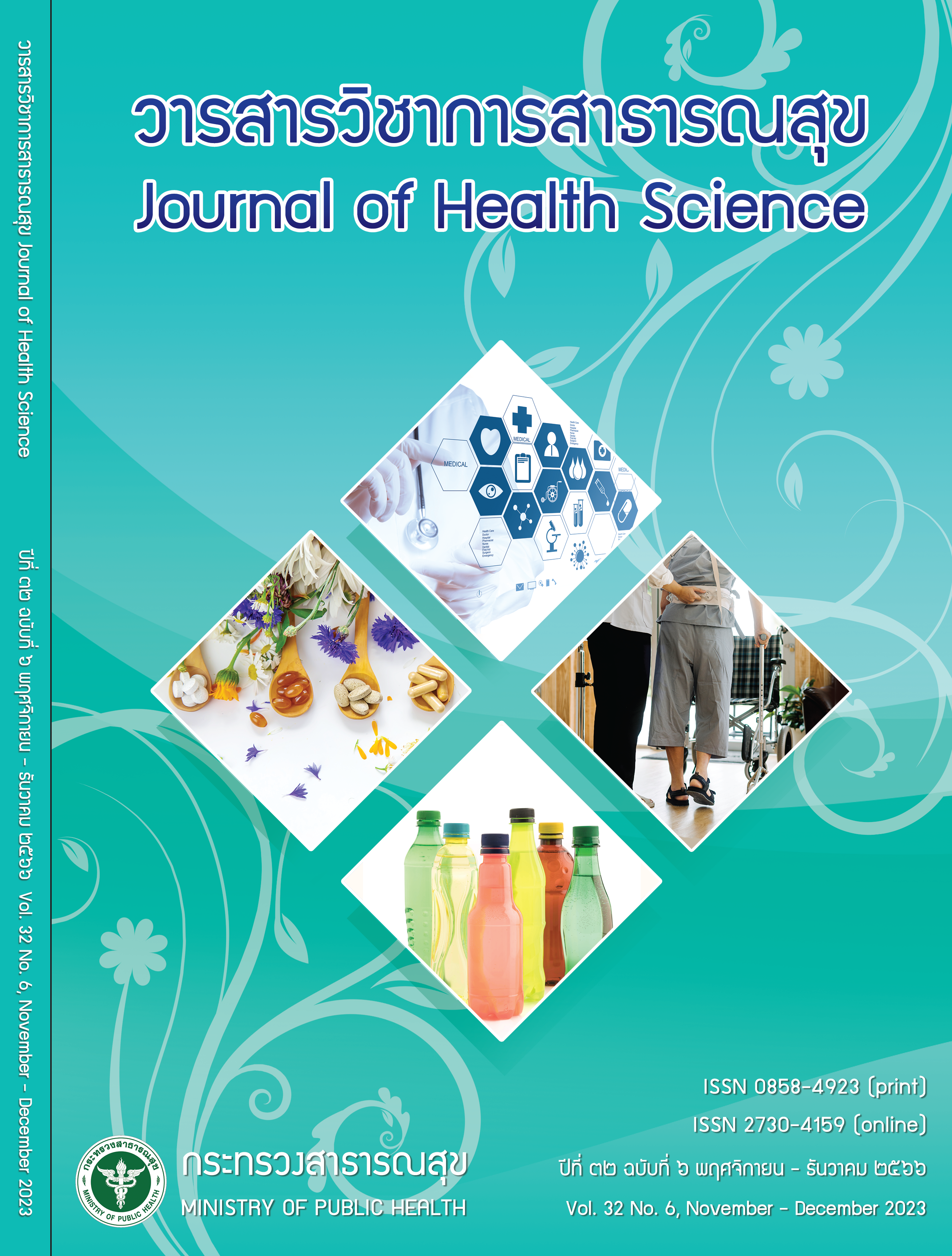Quantity of Dust and Health Risk of Wood Furniture Employees: a Case Study of Ban Donchat, Bung Wai Subdistrict, Warin Chamrap District, Ubonratchathani
Keywords:
respirable dust, health risk, wood furnitureAbstract
A cross-sectional descriptive study was conducted with the objective of examining the particulate matter (dust) levels associated with occupational activities and assessing health risks in 20 locations in Ubol Ratchathani Province. Environmental quality measurements and a health risk matrix assessment were performed, following the methods outlined in the Department of Industrial Works regulations of 2000. The study revealed that the levels of particulate matter, as sampled both personally and in work areas, ranged between 0.31-1.34 mg/m3 and 0.6-1.32 mg/m3 , respectively. These measurements were found to be within the Occupational Safety and Health Administration (OSHA) standards at all monitoring points, indicating compliance with air quality standards. The health risk assessment among workers engaged in bamboo furniture production showed that individual-level risks were generally low (45.0% risk appetite, 45.0% low risk, and 10.0% moderate risk, respectively). Meanwhile, workplace-level risks were predominantly low (50.0% low risk, 45.0% risk appetite, and 5.0% moderate risk, respectively). Prolonged exposure to particulate matter and inadequate use of protective equipment may pose long-term health risks to workers. Therefore, it is crucial for employers and relevant organizations to prioritize and consider particulate matter exposure. They should also establish plans for managing and mitigating dust exposure among workers and informal labor groups. Continuous monitoring and assessment of the health status and occupational risks among informal labor groups are essential.
Downloads
References
พาสินี สุนากร, องอาจ ถาพรภาษี, พัชริยา บุญกอแก้ว. การ ศึกษาเปรียบเทียบความสามารถในการจับฝุ่นละอองของ พรรณไม้เลื้อย. วารสารวิชาการคณะสถาปัตยกรรมศาสตร์ มหาวิทยาลัยขอนแก่น 2559;15(2):175-86.
กระทรวงแรงงาน. กำหนดมาตรฐานในการบริหารจัดการ และดำเนินการด้านความปลอดภัย อาชีวอนามัยและสภาพแวดล้อมในการทำงานเกี่ยวกับความร้อน แสงสว่าง และเสียง พ.ศ. 2559. ราชกิจจานุเบกษา เล่มที่ 133, ตอนที่ 91 ก (ลงวันที่ 17 ตุลาคม 2559).
จารุนิล ไชยพรม, ชวพรพรรณ จันทร์ประสิทธิ์ , วรันธรณ์ จงรุ่งโรจน์สกุล. ภาวะสุขภาพตามความเสี่ยงจากการทำงานของแรงงานนอกระบบเฟอร์นิเจอร์ไม้ อำเภอวังชิ้น จังหวัดแพร่. พยาบาลสาร 2559;43(1):70-83.
ชวพรพรรณ จันทร์ประสิทธิ์ , ธานี แก้วธรรมานุกูล, วันเพ็ญ ทรงคำ, ญาดาทิพย์ เจริญทรัพย์. การชี้บ่งปัจจัยคุกคาม สุขภาพ ภาวะสุขภาพ การบาดเจ็บที่เกี่ยวเนื่องจากการ ทำงาน: การวิเคราะห์สถานการณ์ในอุสาหกรรมขนาดกลาง และขนาดย่อม. พยาบาลสาร 2553;37(1):1-14.
Occupational Safety and Health Administration (OSHA). A guide for protecting workers from woodworking hazards. Washington, DC: Federal Government of USA; 1999.
Su TA, Hoe VC, Masilamani R, Mahmud AB. Hand-arm vibration syndrome among a group of construction workers in Malaysia. Occupational and Environmental Medicine 2011;68(1):58-63.
Aguwa F, Okeke T, Asuzu M. The prevalence of occupational asthma and rhinitis woodworkers in south-eastern Nigeria. Tanzania Health Research Bulletin 2007; 9(1):52-5.
Sripaiboonkij P, Phanprasit W, Jaakkola MS. Respiratory and skin effects of exposure to wood dust from the rubber tree Hevea brasiliensis. Occupational and Environmental Medicine 2009;66 (7):442-7.
ธีรวิโรจน์ เทศกะทึก. อาชีวอนามัยและความปลอดภัย. พิมพ์ ครั้งที่ 3. กรุงเทพมหานคร: โอเดียนสโตร์; 2551.
Herbert FA, Hessel PA, Melenka LS, Yoshida K, Nakaza M. Pulmonary effects of simultaneous exposures to MDI formaldehyde and wood dust on workers in an oriented strand board plant. Journal of Occupational and Environmental Medicine 1995;37(4):461-5.
Blot WJ, Chow WH, McLaughlin JK. Wood dust and nasal cancer risk. Journal of Occupational and Environmental Medicine 1997;39(2):148-56.
รัชนี ขุมเงิน. รายงานการดำเนินงานประจำปี พ.ศ. 2564. อุบลราชธานี: โรงพยาบาลส่งเสริมสุขภาพตำบลทุ่งบอน ตำบลบุ่งหวาย; 2564.
สมัชชาสุขภาพแห่งชาติ. นโยบายสาธารณะเพื่อสุขภาวะของ แรงงานนอกระบบ [อินเทอร์เน็ต]. 2551 [สืบค้นเมื่อ 1 ต.ค. 2564]. แหล่งข้อมูล: http://blog.spko.moph.go.th/osm/ wpcontent/uploads/2008/10/16.pdf
Occupational Safety and Health Administration (OSHA). Revised combustible dust national emphasis program [Internet]. 2023 [cited 2023 Apr 7]. Available from: https://www.osha.gov/sites/default/files/enforcement/ directives/CPL_03-00-008.pdf
กระทรวงอุตสาหกรรม. กำหนดมาตรฐานผลิตภัณฑ์ อุตสาหกรรม การประเมินความเสี่ยงด้านสารเคมีต่อสุขภาพ ผู้ปฏิบัติงานในโรงงานอุตสาหกรรม พ.ศ. 2555. ราชกิจจานุเบกษา เล่มที่ 129, ตอนพิเศษ 146 ง (ลงวันที่ 21 กันยายน 2555).
อุบล สิงห์แก้ว. ผลกระทบทางสุขภาพของประชาชนจากการ ประกอบอาชีพไม้แกะสลัก: กรณีศึกษา บ้านถวาย ตำบลขุนคง อำเภอเมืองหางดง จังหวัดเชียงใหม่ [วิทยานิพนธ์ ปริญญาสาธารณสุขศาสตรมหาบัณฑิต]. เชียงใหม่: มหาวิทยาลัยเชียงใหม่; 2547. 86 หน้า.
Vanadzinš I, Eglîte M, Bake M, SprudŽa D, Martinsone Ž, Mârtinsone I, el al. Estimation of risk factors of the work environment and analysis of employees’ self estimation in the wood processing industry. Journal of Latvian Academy of Sciences 2010;64(1/2): 73-8.
สุภาณี จันทร์ศิริ. สภาวะฝุ่นละอองในสิ่งแวดล้อมการทำงาน และสภาวะสุขภาพของผู้ประกอบอาชีพหัตกรรมหมอนขิด กรณีศึกษา: ตำบลศรีฐาน อำเภอป่าติ้ว จังหวัดยโสธร. [วิทยานิพนธ์ปริญญาสาธารณสุขศาสตรมหาบัณฑิต]. ขอนแก่น: มหาวิทยาลัยขอนแก่น; 2557. 85 หน้า
อดุลย์ บัณฑุกุล. ตำราอาชีวเวชศาสตร์. กรุงเทพมหานคร: ราชทัณฑ์; 2554.
Downloads
Published
How to Cite
Issue
Section
License

This work is licensed under a Creative Commons Attribution-NonCommercial-NoDerivatives 4.0 International License.







